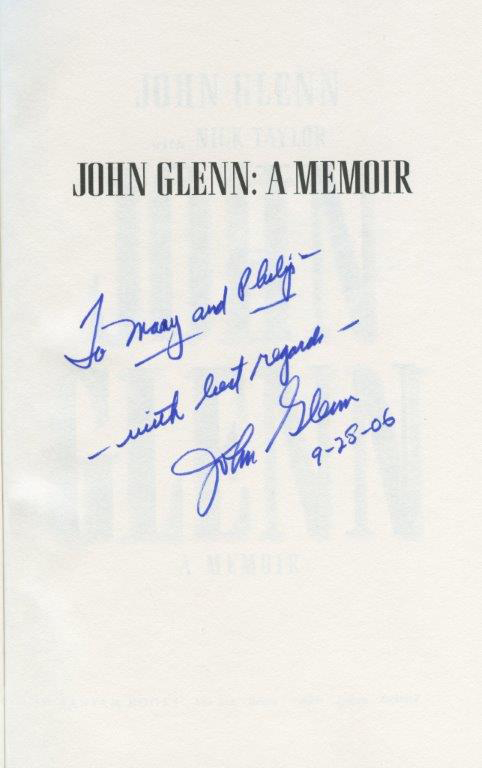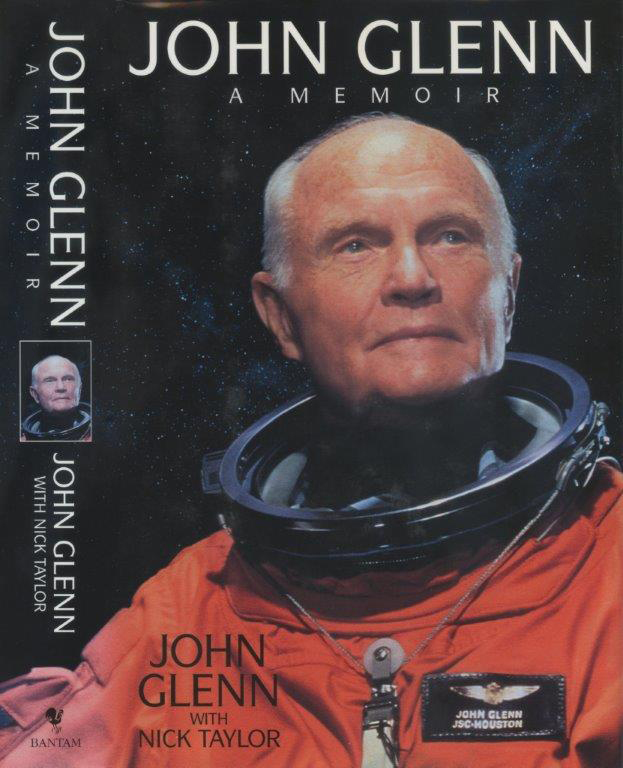The Night I Met My Hero John Glenn
By Philip Handleman
December 22, 2016 - On February 20, 1962, all students in my elementary school were summoned to the gym. We sat on the floor in front of a big rabbit-eared TV and watched the fuzzy black-and-white live feed of John Glenn’s Friendship 7 thundering heavenward on its Atlas booster. The images were captivating.
Many years later, after the celebrated space traveler had journeyed once more into space aboard the space shuttle Discovery, he was scheduled to deliver a speech at a community college in a working-class suburb of Detroit and I was given the honor of introducing him to a standing-room-only audience. When Col. Glenn arrived at the side room where I was waiting with my wife Mary, he extended his arm to shake hands.
I felt a surge of emotions including disbelief that I could actually be meeting this outsized hero from my youth. He had undoubtedly heard thousands of people like me recount their memories of watching his first space launch, but rather than shrugging it off he responded with exceptional grace. Our conversation veered to what we had in common – our time coming of age in Ohio, albeit spread apart by a generation, and our interest in aviation.
In the 1930s, his father had driven him from New Concord to Cleveland to see the National Air Races. It was the sight and sound of those interwar speedsters along with dashing personalities like the mustachioed racing champion Roscoe Turner that had instilled the young Glenn with a passion for flight. I explained that my mother had lived on the periphery of Cleveland Municipal Airport (now Hopkins International) and used to climb the fence to get into those air races. Years later, as a parent she imparted stories of Roscoe and his cohorts, which spurred my desire to fly.
Five minutes to curtain call and we were sequestered, just Glenn and I, in a dimly-lit area backstage. I confided that I was jittery about my introduction in front of a full-capacity audience. With calming words, he offered a reassurance that made me understand why squadron mates would want him to be their wingman.
The voice of a senior faculty member intoned over the public-address system, preparing the audience for my imminent appearance on stage. The professor described my aviation activities, which included regular flights in my early 1940s Navy Stearman biplane trainer. Upon hearing this, Glenn’s face lit up with a big smile. The wood-and-fabric aircraft was exactly the type in which he had begun his military flight instruction, silk scarf flapping in the slipstream. It was the beginning of his progression ultimately to spaceships on trips beyond our atmosphere.
He gazed up at the ceiling, the twinkle in his eyes penetrating to the inky sky beyond. Still smiling, he turned to me, clearly prompted by joyous memories of the air gushing across his face in open-cockpit hops, and with a lilt in his voice said, “Oh, Philip, that’s the best kind of flying!” I smiled back with a nod, feeling the bond between us as men of the air.
My introduction of Glenn ran three-and-a-half pages. Only one sentence covered his senatorial career, which interestingly enough had exceeded his time in the Marine Corps and NASA. Politics does not have the majesty of exploration.
The speech was an ill-conceived and convoluted disquisition on the reform of our educational system, a real snoozer that made it obvious why this humble man in the age of the electronic media had such a long, arduous road to public office and why his presidential bid failed before ever really getting off the ground. The very character traits that accounted for his success in the air doomed him to the slippery slopes that complicate the earthly pursuit of elective office.
It didn’t matter to the hundreds who packed the auditorium. Attendees came to see the former astronaut who had famously radioed from his capsule that all was A-OK. Some parents even brought their children dressed in spacesuits. The forgettable speech was accepted as the price of admission, the sermon before the feast. All the questions that followed had to do with flight and Glenn was at his best regaling the audience with reminiscences of his glory days at NASA.
To capture the essence of the guest speaker, I quoted Walter Lippmann, one of the leading essayists of the 20th century, who had written an eloquent requiem for Amelia Earhart shortly after she went missing on her attempt to fly around the world in the summer of 1937. The timeless elegiac passage answers how the human spirit can rise to ennobling heights. Now that the last of the Mercury Seven, our trailblazers in space, is gone, such praise for the virtues embodied in tenacious explorers takes on added poignancy.
“It is somehow reassuring to think that there are also men and women who take the risks themselves, who pit themselves not against their fellow beings but against the immensity and the violence of the natural world, who are brave without cruelty to others and impassioned with an idea that dignifies all who contemplate it. No preconceived theory fits them. No material purpose actuates them. They do the useless, brave, noble, the divinely foolish, and the very wisest things that are done by man. And what they prove to themselves and to others is that man is no mere creature of his habits, no mere automaton in his routine, no mere cog in the collective machine, but that in the dust of which he is made there is also fire, lighted now and then by great winds from the sky.”
And then, glancing to stage left where Glenn stood waiting for his cue, I invoked the well-worn phrase from his first leap into space, reminding the audience of the momentous occasion when it seemed the whole world had come to a standstill to wish this intrepid voyager the goodwill of the planet he was destined to orbit three times that day. It was CAPCOM’s message sent up at liftoff, a message that turned out to be fitting not only for my introduction but for the inevitable final farewell: “Godspeed, John Glenn!”
Philip Handleman is a longtime pilot and airport owner as well as the author of 22 aviation books.


